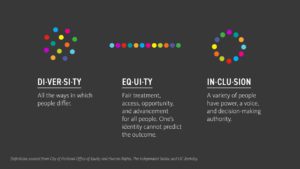Inclusivity translates differently for different employees in the workplace. Leaders and decision makers in the workplace, must fully understand what workplace inclusivity entails to provide a safe work environment for their employees. An inclusive workplace creates a workplace culture that values differences within employees. It also creates a workplace that is not homogenous. Workplace inclusivity harbours an environment that celebrates and paves the way for employees from different backgrounds and social positionings to contribute to the work output of the organisation.

However, due to a lack of understanding, many organisations are unable to fully grasp what workplace inclusivity means. Many leaders may also often confuse diversity to inclusivity within their workplace. Workplace diversity refers to an organisation having employees from a varied demographics. However, workplace inclusivity refers to organisations building a workplace culture that allows employees from different social groups to feel safe within the workplace.
What Does Diversity, Inclusion and Equity Mean?
While the renewed energy behind organisations channelling their resources towards these diversity, inclusion and equity have been present, there still exists a disconnect while understanding what they actually mean. Oftentimes, this leads to organisations having a non-specific idea behind what kind of workplace inclusivity they truly wish to achieve. While organisations may focus on equity measures to build a diverse workforce, a lack of inclusive measures that creates a safe environment for all employees can cause obstructions for the organisation.
At a workplace, diversity would refer to having a workforce that includes employees from different socio-economic backgrounds. However, organisations must understand that diversity refers to developing a workforce that celebrates differences instead of homogenising them. Moreover, diversity also refers to building leadership that is diverse as much as focusing on building an employee group that is diverse.
View this post on Instagram
Building a leadership that is diverse plays into building workplace inclusivity. For marginalised employee groups, diversification of the corporate vertical helps them feel comfortable within their place of work. Inclusion refers to how employees feel a sense of belonging in their place of work. An organisation that prioritises diversity may not always be successful in building an inclusive workplace. For example, even though there might be representation for transgender employees within the workforce, a lack of gender-neutral washrooms creates an obstruction to workplace inclusivity.
While diversity and inclusion refer to representation and building safe spaces within the workplace, equity is a measure to ensure fair processes for marginalised employee groups. This refers to creating access, opportunity and space for marginalised employee groups. Equity is a way to ensure that marginalised employee groups have fair access to advancements compared to privileged employee groups. Equity takes into account the fact that policies and processes have historically been unfair to marginalised gender groups. Hence, moving forward these policies and processes must change to ensure that marginalised employee groups have access to opportunities as much as anyone else.
Many organisations often confuse equity and equality. While equality refers to providing same resources to all employee groups, equity takes into account intersectionality to ensure that the right number of resources are allocated to each employee group. This means, that equity takes into account unique struggles and hindrances while resource allocation for marginalised employee groups.
Understanding Intersectionality for Workplace Inclusivity
An intersectional approach to workplace inclusivity builds a workplace culture that all employees fee safe within. Intersectionality within the workplace, refers to understanding levels of marginalisation for certain employee groups. For example, a cis-woman may face sexism at the workplace, a trans-woman is at the risk of facing sexism and transphobia due to a lack of understanding. An essentialised approach to workplace inclusivity that doesn’t pay attention to intersection of identities, may cause harm to business output. Workplaces that thrive on inclusivity are able to build employee productivity due to collaborative processes as well as a diverse workforce that contributes equally to revenue generation.
An intersectional approach hence, allows leaders and decision makers to fully understand how different employee groups interact with each other. A diverse workforce that consists of employees of different gender, sexuality, age and social location can only be productive if employees are able to build workplace inclusivity that fosters their potentials. Understanding different employee identities and working towards making a safe workplace culture are an important way to ensure the same.
How Advisories Help Build Workplace Inclusivity?
Advisories that focus on building workplace inclusivity are able to understand how workplaces evolve into becoming truly inclusive. They focus on building training and sensitisation blocks that are able to help leaders in the workplace understand how to foster workplace inclusivity. Moreover, advisories like Ungender also focus on creating a continual learning environment that helps leaders address their own biases and combat workplace stereotypes. Moreover, advisories are able to build knowledge-based training programs as well as harbour sensitivity within decision makers at the workplace.
It is also important for workplaces to truly understand how programs can be made relevant for their specific culture. Advisories are able to curate training and sensitization sessions that help organisation traverse beyond legal mandates and build a sense of belonging for their employees. Workplace inclusivity also helps organisation improve employee morale and productivity. Advisories that build customised diversity and inclusion plans are able to help organisations achieve the same.
Moreover, advisories also help organisations acknowledge the need for diversity within their organisations and consequently help them put policies and processes in place that foster workplace inclusivity. Workplace inclusivity is an integral way to raise awareness among decision makers as well as build solidarity among employees to boost employee morale. Advisories that place importance on these training programs while also focusing on policy implementation can help organisations build workplace inclusivity for a higher impact within as well as outside the organisation.
Written by: Anuska Roy
Ungender Insights is the product of our learning from advisory work at Ungender. Our team specializes in advising workplaces on workplace diversity and inclusion. Write to us at contact@ungender.in to understand how we can partner with your organization to build a more inclusive workplace.










